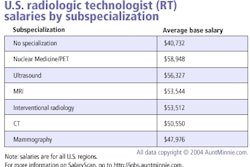BOSTON - Getting financing to build a new diagnostic imaging center requires a business plan that is both thorough and compelling. Careful attention to detail increases the likelihood of finding funds to back such a venture, according to imaging center startup veteran Lisa Brockett.
"It all boils down to how much cash you're going to be bringing in against how much you'll be paying out and if you're going to make a profit," said Brockett, chief operating officer and co-founder of Trinity Health Care, a Newport Beach, CA-based diagnostic imaging center management firm.
Brockett shared her experience in putting together a successful business plan for financing an imaging center at the American Healthcare Radiology Administrators meeting on Sunday.
A sum of parts
"The first step in putting together an imaging center business plan is to define the opportunity," Brockett said.
This requires that an entrepreneur collect demographic information on the center's catchment area, patient-care backlog, market changes, competition, and any managed-care opportunities in the area. The data will form the basis of the first part of the business plan, the executive summary, according to Brockett.
The next step is to define the principals in the proposed venture. The documentation should speak to the experience of each of the members. Principals who should be defined in an imaging center business plan are the radiologists, management team, marketing director, and a billing and collections manager.
If a contractor will be providing services such as billing and collections or marketing, the contracting firm should be briefly profiled, Brockett said. The executive personnel information will form the second part of the business plan, the executive biographies.
The third step is to quantify the opportunity. This entails defining the modalities that will be available to referring physicians, the location of the imaging center, its hours of operation, and the projected staffing of the venture.
"As far as a location goes, you'll generally want some other medical facilities around the proposed site of your imaging center. That's something lenders will be looking for," Brockett said.
Data deluge
Quantifying the opportunity requires gathering and refining the information that will serve as the underpinning of the business plan, Brockett said. Revenue information such as area payor mix and average reimbursement per modality will need to be obtained.
Equipment costs, such as the initial price of the equipment, plus tax, warranty period, maintenance expenses, and upgrades of the equipment every 5-7 years will need to be specified. In addition, the monthly cost of any financing on the equipment should be disclosed in the business plan, Brockett said.
Staff costs will also need to be included in the plan. Entrepreneurs need to come up with realistic numbers for technical staff on a per-modality basis, as well as administrative personnel, marketing staff, and front-office and medical-records staff. This should include the base pay for each designation, an overtime estimate (Brockett recommended factoring in 10%-15%), taxes, insurance, and benefits.
Facility costs must also be revealed. These items include rent, lease terms and options, leasehold requirements, and signage. If leasehold improvements are going to be made, which is almost a certainty unless one is taking over an existing imaging center, these improvements need to be disclosed in the business plan.
To this end, contractors' quotes, as well as the experience of the contractors in building out imaging centers, should be detailed. And depending on the real estate market where the center will be located, if the landlord will be providing any price breaks in terms of decreased rent or an extended lease at a fixed price, these reimbursements should be noted. The monthly cost of financing the note on the facility will need to be part of the business plan.
The rest of the image
Service costs are an important part of the business plan. These include the cost of the radiologists, transcription, billing and collection, accounting, and legal fees. If the center plans to use outsourced services, such as marketing, management, or janitorial, these should be noted as well.
Various other elements such as per-modality supply costs for items such as film, film jackets, contrast, prep consumables, and so on should be disclosed. Projected insurance costs for general and professional insurance will need to be included in the business plan. Initial marketing costs for the center will need to be determined, as well the cost for ongoing marketing of the center.
The cost of furniture, fixtures, equipment, utilities, and parking (if applicable) for the center will need to be determined as part of the opportunity quantification. This area of the business plan also includes computers and computer software such as RIS, PACS, billing, accounting, and administrative applications needed to conduct business. If financing was utilized for any or all of these items, the monthly cost of the note will need to be included as part of the plan.
Brockett said it is crucial to document and include demographic, revenue, and cost information in the business plan.
"When the plan is reviewed by the financier's credit team, you'll be able to point them to the supporting documentation when they question where you came up with the numbers in your pro forma," she said.
Pro forma
The data collection conducted as part of the opportunity quantification will serve to generate the numbers that make up the bulk of the pro forma section of the business plan. These are essentially business assumptions of projected revenue against established liabilities that are derived from the collected data.
"A classic pro forma structure will include worst-case, most likely, and best-case scenarios," Brockett said. "I recommend conducting a pro forma of all three cases for internal use, but the one you want to present outside the company is the most-likely-scenario pro forma."
In addition to including the varied revenue assumptions on a per modality basis and a detailed breakdown of all potential liabilities for the imaging center venture, financiers will want to see sources of funding for the proposed project. This will include any joint-venture partner funding, such as hospital funds, leasehold improvements, loans, and equity participation.
"Equity participation of the principals involved in the project is normally required to obtain project financing," Brockett said. "Financing companies will want at least three months' worth of working capital committed to the project. In addition, the principals may have to cover leasehold improvements as well as other small capital improvements not covered via loans."
Getting good data on every aspect of a proposed venture, refining it to its smallest elements, and presenting it in a comprehensive business plan increases the likelihood that an imaging center will find the financing it needs.
"A good business plan shows that a group is committed to doing the work necessary to ensure its viability and success," Brockett said.
By Jonathan S. BatchelorAuntMinnie.com staff writer
August 3, 2004
Related Reading
Healthcare IT, practice automation crucial for meeting rising costs, May 20, 2004
Six Sigma tools improve patient throughput, January 2, 2004
Workflow analysis can ease scheduling woes, November 28, 2003
Imaging centers ready to handle cost-conscious market, April 3, 2003
Billing blues: Eliminating denials for imaging services, March 13, 2003
Copyright © 2004 AuntMinnie.com



















